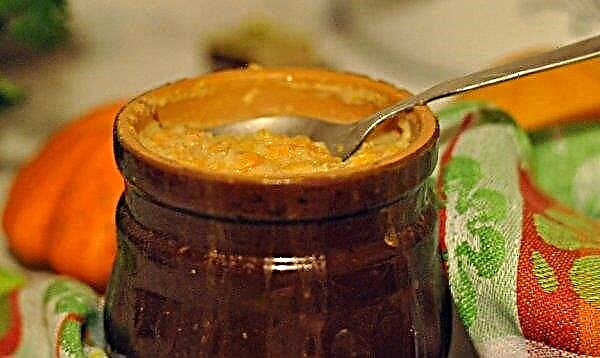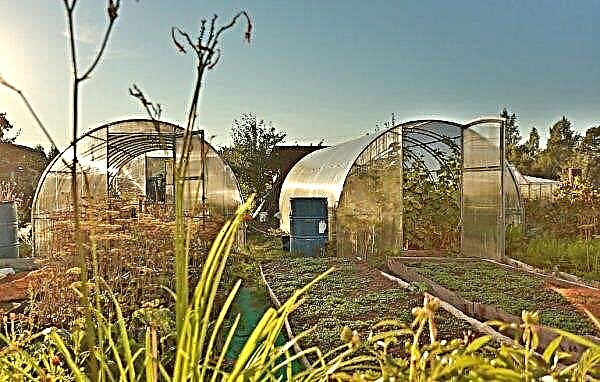It is difficult to imagine the menu of the average citizen of our country without potatoes. This vegetable has become an integral part of the daily diet. Accordingly, the cultivation of this crop occupies a huge place in the agricultural sector. Breeders have bred many varieties of potatoes. In this article, we consider the features of growing a variety called Ivan da Marya.
Origin history
Ivan da Maria - the popular name for the potato of the Dutch selection of Picasso. In some sources, it is also called Little Red Riding Hood, Gorbachevka, Matryoshka, etc. Since 1995, he has been included in the State Register and has since become widespread in many regions of the country because of its unpretentiousness. The potato has a catchy pockmarked pink and yellow color.
Did you know? Homeland potatoes - South America. Wild potatoes still grow there.
Characteristic and Description
The characteristic of this variety is as follows:
- It is a late-ripening vegetable with a ripening period of 120-130 days after planting. But this period can last longer, depending on weather conditions.
- The bushes are tall, with large foliage, the flowers are white and cream.
- The fruits are round-oval, have a light yellow peel, with a small number of pink eyes. Creamy flesh.
- The average weight of the root crop is 100–120 g. More than 20 tubers can be obtained from the bush.
- It has good taste. In cooking, suitable for any potato dishes.

Advantages and disadvantages
- Of the advantages it should be noted:
- a high percentage of presentation of the crop (more than 90%);
- it is well stored and transported, the shelf life reaches 90%;
- drought tolerance (can tolerate temperature changes);
- unpretentiousness;
- resistance to many diseases.
- Disadvantages:
- with a lack of moisture, yield decreases;
- the need to update planting material, because over time it loses its properties.
Planting potatoes
The requirements for planting Ivan da Marya potato varieties are generally consistent with the rules relating to the planting of this crop - this is the preparation of the soil, planting material, compliance with the feeding and watering regime, and planting patterns.
Optimal landing times
It is better to wait until the soil warms up (should not be less than +8 ... + 10 ° С). The usual time for planting potatoes is the end of April-May.
Soil requirements
Potatoes Ivan da Maria loves light, slightly acidic soil (pH 5.5–6.5), which must be prepared in the fall: to clear the site of plant debris, to introduce manure or humus, as well as superphosphate and ash. Since potatoes are a solanaceous crop, the predecessors should not be vegetables of this group (pepper, tomato).
Carrots and other root vegetables (with the exception of beets) are also not recommended. But it will be good to plant siderata in front of the potatoes: peas, beans, mustard, etc. Cucumbers with cabbage are good predecessors.
Important! The site should be selected well-lit, not in the lowlands.
Preparing planting material
For planting, only healthy tubers are selected without damage, medium size. Large tubers can be cut in half. If there are thin shoots on potatoes, they need to be cut off. This variety may not be germinated before planting, although germination accelerates the process of ripening the crop.
They begin to prepare planting material from mid-March to early April. To do this, put it in a warm, bright place at a temperature of up to +14 ... + 16 ° С (but not in direct sunlight) for 2-3 weeks. During this time, it should turn green and germinate. To save space, you can lay tubers in boxes, but preferably in one layer.
Before planting, potatoes can be treated with antibacterial drugs or stimulants, for example, soaked in a weak solution of potassium permanganate (1 g per 1 liter of water) or wood ash (1 kg per 10 l) for half an hour.
Landing technology
When planting, you should leave a distance of 60–70 cm between rows, and 40–45 cm between bushes. Ashes and humus are added to the hole and mixed with the ground, then they are well watered and the potatoes are laid so that as many eyes as possible are at the top.
Some farmers recommend sprinkling ash after the tubers are sprinkled with earth. In this case, the beneficial substances will penetrate the soil after each irrigation and feed the planting material.
You can plant tubers in trenches to a depth of 5 cm, or you can plant them at ground level, and make an embankment 10 cm thick on top. This method will provide better aeration.
Alternative cultivation methods, such as planting under straw, are also suitable for the Ivan da Marya variety. In this case, the tubers are placed in the soil to a depth of not more than 2 cm and sprinkled with earth. If the soil is very dry, you need to moisten it. Then, straw is spread over thickly.
This will simplify the care of potatoes (you do not need to loosen and hush bushes all the time) and increase its productivity. Under the straw, root vegetables breathe perfectly, and this material also serves as a wonderful mulch, which protects against drying out and temperature changes.
Important! The planting method is directly dependent on natural conditions. In a very windy area, the latter method will not be very good.
Care Features
Much attention should be paid to loosening and hilling of potato plantings for good breathability of the soil.
Fertilizer
Fertilize the planting several times during the growing season.
Root dressing is carried out:
- A month after planting, bird droppings or cow dung (about 500 g) are taken per 1 bucket of water and mixed with 2 tbsp. l urea.
- During the budding period, take a glass of ash and about 50 g of potassium sulfate and dilute in 1 bucket of water.
- During flowering, superphosphate is mixed in an amount of 2 tbsp. and 1 tbsp. nitrofosks for the same volume of water.
Root top dressing should be performed not directly under the bush, but in the furrows 10-15 cm from the bushes.
Spraying plants is carried out 1 time, after flowering. Superphosphate (100 g per 1 bucket of water) is used for this.
Weed cleaning
Harrowing between rows with weed weeding for the first time is carried out a week after planting. Further cultivation is carried out every week and always after watering.
It is recommended that they hobby 2 times, forming mounds of about 10 cm: when the sprouts reach 10-15 cm, as well as after the appearance of buds. But it should be noted that if there is a threat of frost, only hatching sprouts should be spudded.
Hilling increases the number of tubers, i.e., new stolons (shoots on which new fruits will appear) will form under the earthen mound. This process is recommended to be performed in the morning or in the evening, and also after rain or watering, because if you fall asleep on dry ground, insufficient moisture will come in and the stolons will not grow.
This process is recommended to be performed in the morning or in the evening, and also after rain or watering, because if you fall asleep on dry ground, insufficient moisture will come in and the stolons will not grow.
Did you know? The most expensive potato in the world is La Bonnotte, which is grown on the island of Noirmoutier. She is very tender and delicious. The cost of 1 kg of such potatoes is about 500 euros.
Watering
It is recommended to water the potatoes Ivan da Marya by the drip and better in the grooves between the rows. In dry weather, watering should be done at least once a week, and during flowering should increase the frequency. In this case, the norm for 1 bush is about 3 liters of water.
If the weather is too rainy, you do not need to use additional watering. After flowering, watering can be reduced to 1 time per week. An indicator of a lack of moisture will be slightly grafted leaves.
During flowering, the soil should be mulched with mowed grass or hay to better maintain moisture.
Pest and Disease Control
The variety is resistant to many diseases: viruses A and Y, potato cancer, nematodes, late blight of tubers. It is medium resistant to twisting of leaves and late blight of the tops. From phytophthora they use the Agat-25K agent, and potassium fertilizers help from twisting the leaves. But the scab variety has a high susceptibility. The risk of occurrence is especially increased if the pH of the soil is more than 7.5, i.e. the soil is not acidic. From this ailment, before planting, you can treat the tubers with fungicidal preparations: Phytoplus, Fungazil, etc. You can acidify the soil by adding potassium or ammonium sulfate (30 g / 1 m²).
But the scab variety has a high susceptibility. The risk of occurrence is especially increased if the pH of the soil is more than 7.5, i.e. the soil is not acidic. From this ailment, before planting, you can treat the tubers with fungicidal preparations: Phytoplus, Fungazil, etc. You can acidify the soil by adding potassium or ammonium sulfate (30 g / 1 m²).
Of the pests, the biggest problems are the Colorado beetles. Fortunately, there are many drugs to combat them (Iskra, Zubr, etc.). In addition to chemicals, you can pollinate the tops with wood ash and sprinkle with garlic infusion. You can also plant marigolds and garlic between rows to deter pests.
Preventive measures against diseases are:
- compliance with the proper agricultural techniques of growing crops;
- ungrounded planting;
- timely watering, top dressing and weeding.
Harvesting and storage
Since the maturation period for potatoes can vary, it is recommended to dig one bush first and evaluate the size of the tubers. Typically, harvesting occurs in the second half of September. An indicator of maturity will also be drying tops. Digging potatoes is recommended in dry weather. Productivity in different regions reaches 200–300 c / 1 ha.
Only whole fruits should be selected for storage, then the shelf life will reach 90%. For better preservation, tubers can be sprayed with a solution of copper sulfate (2 g per 1 bucket of water). It is better to store the crop in well-ventilated boxes, at a temperature of +2 ... + 4 ° С. When the temperature decreases, the potato will lose its taste, and at a higher temperature it will begin to sprout and deteriorate.
When the temperature decreases, the potato will lose its taste, and at a higher temperature it will begin to sprout and deteriorate.
Despite the fact that now there are many new breeding varieties of potatoes, Ivan da Marya still does not lose popularity among gardeners. They choose him for his unpretentiousness in care, good marketable appearance, as well as for his culinary qualities.












